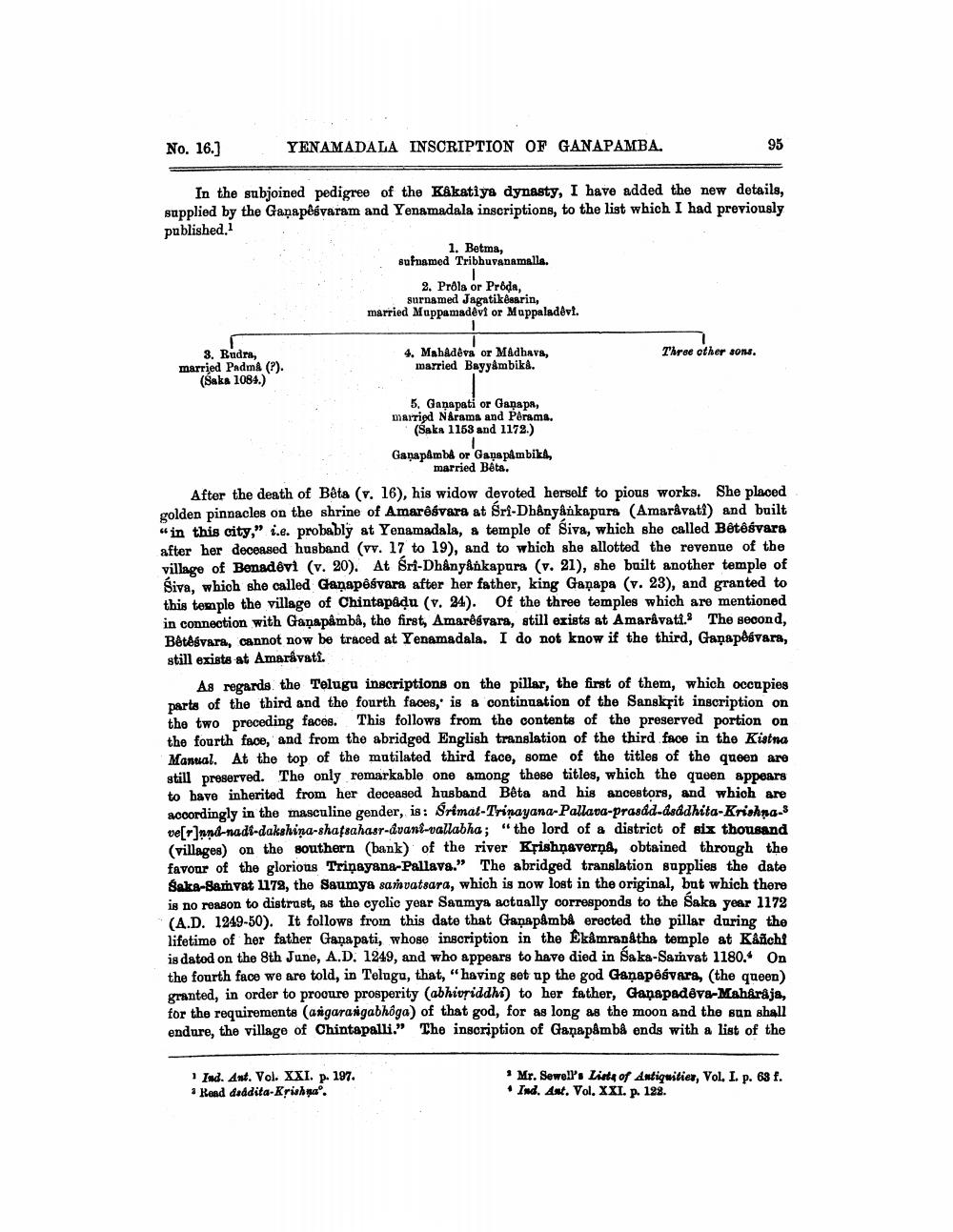________________
No. 16.)
YENAMADALA INSCRIPTION OF GANAPAMBA.
In the subjoined pedigree of the Kakatiya dynasty, I have added the new details, supplied by the Ganapē varam and Yenamadala inscriptions, to the list which I had previously published. 1
1. Betma, sufnamed Tribhuvanamalla.
2. Prôla or Proda,
surnamed Jagatikêaarin, married Mappamadevi or Muppaladevt.
8. Rudra, married Padma (?).
(Saks 1084.)
4. Mabadeva or Madhava, married Bayyâmbika.
Three other sons.
5. Ganapati or Ganapa, married Nárams and Pêrams.
(Saka 1153 and 1172.)
Ganapambe or Ganspåmbiks,
married Bêts. After the death of Beta (v. 16), his widow devoted herself to pious works. She placed golden pinnacles on the shrine of Amarêśvara at Sri-Dhanyánkapurs (Amaravati) and built « in this city," i.e. probably at Yenamadala, & temple of Siva, which she called Bêtêsvara after her deceased husband (vv. 17 to 19), and to which she allotted the revenue of the village of Benadovi (v. 20). At Sri-Dhányánkapara (v. 21), she built another temple of Siva, which she called Ganapéávara after her father, king Ganapa (v. 23), and granted to this temple the village of Chintapadu (v. 24). Of the three temples which are mentioned in connection with Ganapamba, the first, Amarê vara, still exists at Amaravati. The second, Betagara, cannot now be traced at Yenamadala. I do not know if the third, Ganapēgvara, still exists at Amaravati.
As regards the Telugu inscriptions on the pillar, the first of them, which occupies parts of the third and the fourth faces, is a continuation of the Sansksit inscription on the two preceding faces. This follows from the contents of the preserved portion on the fourth face, and from the abridged English translation of the third face in the Kistna Manual. At the top of the mutilated third face, some of the titles of the queen are still preserved. The only remarkable one among these titles, which the queen appears to have inherited from her deceased husband Bêta and his ancestors, and which are accordingly in the masculine gender, is: Srimat-Trinayana-Pallada-prasdd-&sddhita-Krishna-s vel rInnd-nadi-dakshina-shafsahasr-dvani-vallabha; "the lord of a district of six thousand (villages) on the southern (bank) of the river Krishnaverna, obtained through the favour of the glorious Triņayana-Pallava." The abridged translation supplies the date Saka-Samvat 1172, the Saumya saṁvatsara, which is now lost in the original, but which there is no reason to distrast, as the cyclic year Saumya actually corresponds to the Saka year 1172 (A.D. 1249-50). It follows from this date that Ganapamb erected the pillar during the lifetime of her father Ganapati, whose inscription in the Ekámranatha temple at KAñchi is dated on the 8th June, A.D. 1249, and who appears to have died in Saka-Samvat 1180. On the fourth face we are told, in Telugu, that, "having set up the god Ganaposvara, (the queen) granted, in order to procure prosperity (abhivriddhi) to her father, Ganapadêve-Mahåråja, for the requirements (angarangabhôga) of that god, for as long as the moon and the sun shall endure, the village of Chintapalli." The inscription of Ganapåmbé ends with a list of the
1 Ind. Ant. Vol. XXI. p. 197. Read daddita-Krishna'.
Mr. Sewell's List of Antiquities, Vol. I. p. 63 f. • Ind. Ant. Vol. XXI. p. 122.




